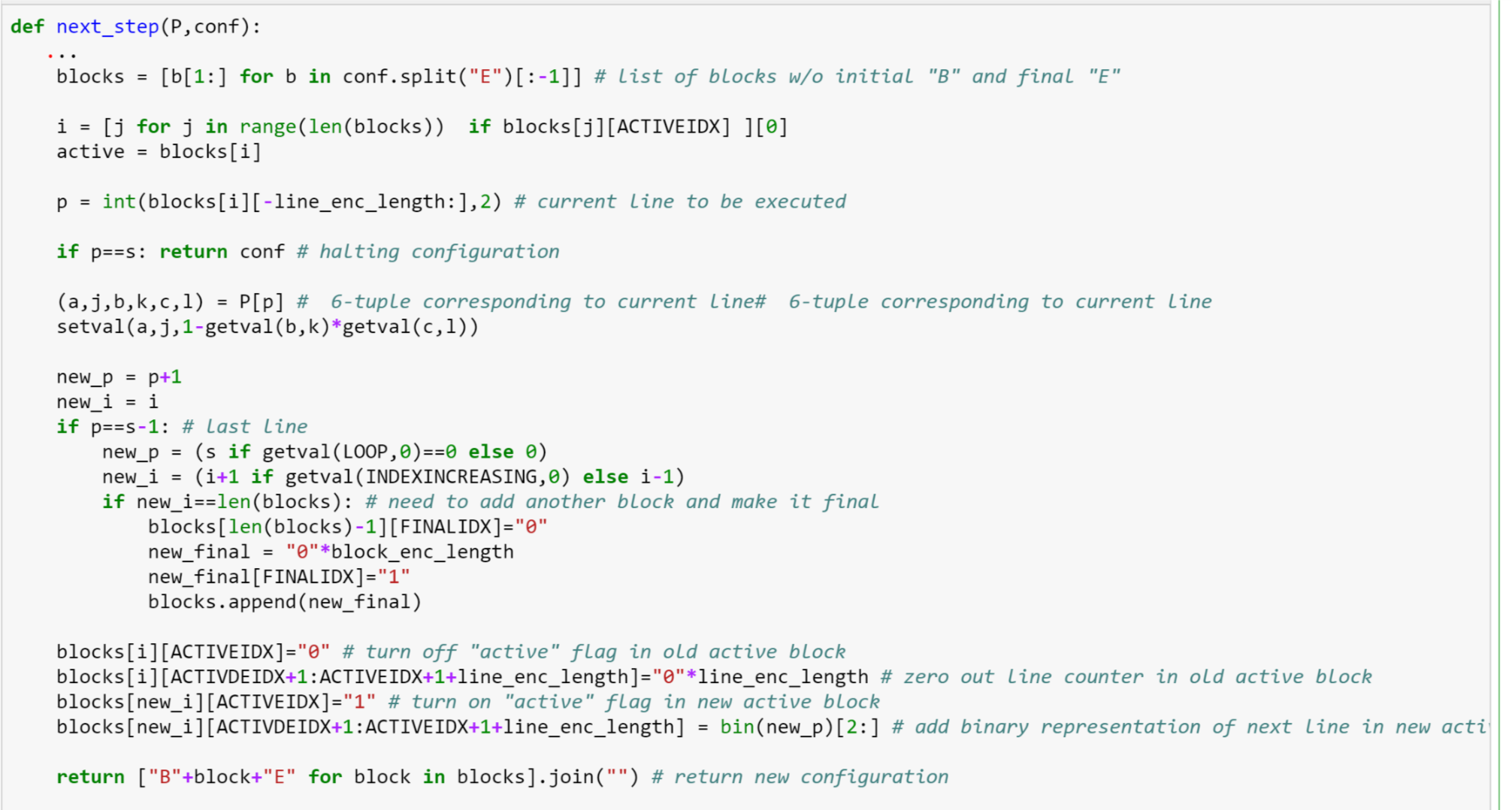N or Space for next slide, P for previous slide, F for full screen, M for menu
Lec 10:Other computational models
Boaz Barak (instructor), Salil Vadhan (co-instructor), Juan Perdomo (Head TF).
Team: Aditya Mahadevan, Brian Sapozhnikov (surveys), Chan Kang (extension), Gabe Abrams (Ed Tech), Gabe Montague (NAND web), Jessica Zhu (proof workshops), John Shen, Juan Esteller (NAND implementation), Karl Otness, Katherine Binney, Mark Goldstein (clicker expert), Stefan Spataru, Susan Xu, Tara Sowrirajan, Thomas Orton (Advanced Section)
Slides will be posted online.

Laptops/phones only on last 3 rows please.
Announcements
Course resources
Calendar
Salil review lecture Tuesday 10/10 evening
Midterm prep questions
Main theorems
No pset before midterm
NAND++ configuration review
Think of variables as arrays
Config: seqeuence of blocks. Initially \(n\)*, eventually largest index reached \(i\).
Main point: Computation is sequence of simple operations.



Modeling computation
1930’s: Three different definitions of “computable functions”
\(\lambda\) calculus (Alonzo Church 1932,1936)
General recursive functions (Kurt Gödel 1934)
Turing machines (Alan Turing 1937)
Church: Conjectured “\(\lambda\) computable = computable”.
Gödel: Unconvinced. Proposes “general recursive”
Church+Kleene: Two definitions equivalent
Gödel: Maybe both equivalent but “wrong”
Turing: Defines “Turing machines” (shows equivalent to \(\lambda\) calculus)
Gödel, Church, everyone: Convinced captures computation
Question
What’s the corresponding element in a Turing machine to the NAND++ index variable i?
a. Current state
b. Alphabet size
c. Head position
d. State transition function
Turing machine
Models person with:
Unbounded sheet of paper (“tape”)
Finite working memory (“states”)
Each step: Read/Write one symbol, update memory, move to adjacent tape location.
Example: Person computing \(a \times b\) using gradeschool algorithm.
Question: Why did Turing try to model a person and not an electronic computer?
Today’s Lecture
NAND<< to NAND++ reduction 1
Features: integer variables | arithmetic operations | arithmetic with index
Question: How can we simulate integer arrays with two dimensional bit arrays?
NAND<< to NAND++ reduction 2
Features: Integer variables | 2-dim arrays | Arithmetic operations | Arithmetic with index
Question: How can we simulate two dimensional arrays with one dimensional arrays?
Answer: Replace the indices \((i,j)\) with \(PAIR(i,j)\) where \(PAIR:\mathbb{N}^2 \rightarrow \mathbb{N}\) is one-to-one (e.g., \(PAIR(x,y)=\tfrac{1}{2}(x+y+1)(x+y)+x\))
NAND<< to NAND++ reduction 3
Features: Integer variables | 2-dim arrays | Arithmetic operations | Arithmetic with index
Question: How can we implement arithmetic operations on bit-representations of integers?
Answer: Like we learned in school
NAND<< to NAND++ reduction 4
Features: Integer variables | 2-dim arrays | Arithmetic operations | Arithmetic with index
Question: How can we use \(i++\) and \(i--\) to implement
COPYTOi(foo)
Answer:
Array
markerinitially set to \((1,0,\ldots)\)Repeat: decrement
fooand move \(1\) inmarkerone step right.Move \(i\) until we reach point where
markeris equal to \(1\).
NAND<< to NAND++ reduction 4
Features: Integer variables | 2-dim arrays | Arithmetic operations | Arithmetic with index | Increment/decrement index
Question: How do we implement \(i++\) and \(i--\) in NAND++?
Answer: “Breadcrumbs” and “wait for bus strategy”
atstart_i initialized to \((1,0,0,0,\ldots)\)
breadcrumbs_i set to \(1\) at the end of every loop
indexincreasing set to \(1\) when at \(i=0\),set to \(0\) at new point.
marker usually all zeroes, set to \(1\) at a point we want to reach again.
Today’s Lecture
Turing machines
Def: A Turing Machine is \(M:[k] \times \Sigma \rightarrow [k] \times \Sigma \times \{L,R\}\)
Turing Machine Simulator (see also this)
Question: Prove that two-way infinite tape is same as one-way infinite tape.
Two-tape TMs = One-tape TMs
Idea: Odd location tape 1, Even location tape 2.
Add “marker” for heads location: \(\Sigma \mapsto \Sigma \times \{ m,u \}\)
Simulate one step:
- Start in even location: go in jumps of two to find “even head” and read value.
- Move to odd, find “odd head” and read value
- Compute new state, vals to be written, directions.
- Scan to find heads and update.
New state: \([k] \mapsto [k] \times [k'] \approx [k\times k']\)
Main Thm
Thm: \(F\) NAND++-computable iff \(F\) TM-computable
Proof: \(\Leftarrow\): easy to simulate TM by NAND<<
\(\Rightarrow\): not hard to simulate NAND++ by TM. (head location = \(i\), state = line number + variables with absolute indices)
TM’s vs NAND++
Today’s Lecture
\(\lambda\) calculus
If \(f = \lambda x.e\) then \(f y\) is \(e[x \rightarrow y]\).
Currying \(\lambda x,y. exp = \lambda x.(\lambda y. exp)\)
Precedence rule: \(f x y = (f x) y\).
Question: Suppose that \(F = \lambda f. (\lambda x. (f x)f)\), \(1 = \lambda x.(\lambda y.x)\) and \(0=\lambda x.(\lambda y.y)\). What is \(F \; 1\; 0\)?
a. \(1\)
b. \(0\)
c. \(\lambda x.1\)
d. \(\lambda x.0\)
\(\lambda\)-computability
Informal: \(F\) is \(\lambda\)-computable if equal to \(\lambda\) expression.
Recall: \(NIL\) - empty list, \(PAIR\) - create pair. List \((a,b,c) = PAIR \; a \; (PAIR \; b \; (PAIR\; c \; NIL))\)
Formal: \(F:\{0,1\}^* \rightarrow \{0,1\}\) is \(\lambda\)-computable if exists \(\lambda\)-expression \(e\) such that for every \(x\in \{0,1\}^n\), \(F(x_0,\ldots,x_{n-1})\) equals
Thm: \(F\) is \(\lambda\)-computable iff \(F\) is NAND++ computable.
Proof: \(\Rightarrow\): repeat “search and replace” to evaluate \(\lambda\) expressions.
\(\Leftarrow\): crucial insight is \(NEXT_P\) is computable by “search and replace”
Preliminaries
- Set \(0 = \lambda x,y.y\) and \(1= \lambda x,y.x\). Then \(IF \; cond \; a \; b = cond \; a \; b\).
- Set \(PAIR = \lambda x,y. (\lambda f. f x y)\), \(HEAD = 1\), \(TAIL = 0\).
- \(NIL = \lambda f.1\), \(ISNIL\; P = P (\lambda x,y.0)\).
To define \(MAP\), \(FILTER\), \(REDUCE\) we need recursion
Y combinator

Turing Eret @turingmachine
Hat-tip: Matt Might (see also Y combinator in Javascript)
Y combinator
Example:
Question: Why is this a recursive definition for \(PAR\; L\)?
Non recursive function:
Lemma: \(PAR = APAR \; APAR\) satisfies equation \(\color{red}{(*)}\)
Proof: Plug \(f=APAR\) in \(\color{green}{(**)}\).
Cor: \(PAR \; L\) is the parity of \(L\) for every list \(L\).
Y combinator
Thm: Let \(Y = \lambda f. (\lambda x. f (x\; x)) (\lambda y. f (y\; y))\). Then for every \(F\), \(f=YF\) solves the recursive/fixed-point equation \(f=F\; f\).
Pf: Write
\(Y\; F = \color{green}{(\lambda x. F (x\; x))} \color{red}{(\lambda y. F (y\; y))}\) =\(\color{green}{F (x\; x)}[x \rightarrow \color{red}{\lambda y.F(y \; y)}]\)
=\(\color{green}{F(}\color{red}{(\lambda y.F(y \; y))} \; \color{red}{(\lambda y.F(y \; y))} \color{green}{)}\)
=\(F(Y F)\)
Using this can define \(FILTER\),\(MAP\),\(REDUCE\), etc..
Simulate NAND++ with \(\lambda\)
Simulate \(NEXT_P\)
Recursively repeat until halt
- Configuration: list of blocks
Crucial observations:
- \(\lambda\) can do AND/OR/NOT \(\Rightarrow\) any finite function
- Next configuration is obtained by finite function applied to finitely many blocks. \(\Rightarrow\) \(FILTER\) to find active block and then constantly many applications of \(MAP\)/\(REDUCE\)
Church-Turing Thesis
“Computable” \(\approx\) TM-computable
= \(\lambda\)-computable
= NAND++ computable
= NAND<< computable
= Python-computable
\(\approx\) “Human computable”
\(\approx\) “Alien computable”
= ….